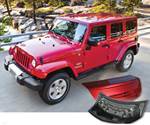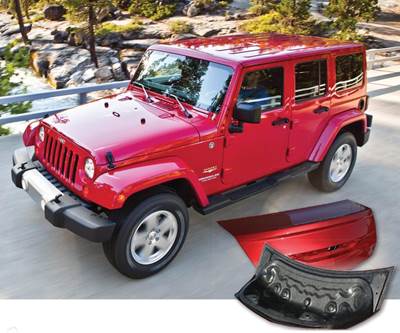SMC 4.0
The story behind the supplier-orchestrated effort that eliminated unacceptable defects levels in painted Class A SMC exterior auto parts.
Problems with painted SMC parts began in the late 1990s, perhaps due to high growth and adoption on high-volume models. “When I started in 1999, Class A applications of SMC had serious issues with edge pops or paint pops,” recalls Mike Siwajek, director of R&D at Continental Structural Plastics (Auburn Hills, MI, US). “We were seeing 250-350 concerns per 1,000 parts, which was unacceptable,” he recalls.
ThyssenKrupp Budd (now CSP) began to catalog the defective parts and do root-cause analyses, tracing 90% of the defects to microcracks in the cured part surface. Siwajek explains, “We were molding the SMC parts and shipping them to the assembly line, where the guys would treat them like steel parts, dropping them, using mallets as they attached them to the BIW. The paint film would cover the microcracked area, trapping air, which would then expand during cycling in the paint oven, causing ‘fish eyes’ all along the edges of the part.”
Siwajek’s team knew it couldn’t control how the auto plants handled the parts, so it worked with resin supplier AOC Resins (Collierville, TN, US) to increase the toughness of the SMC’s polyester matrix. Both ThyssenKrupp Budd and AOC hold patents on the resulting tough Class A (TCA) technology for SMC. “By the end of 2002, Ford had stopped counting SMC paint defects because we had basically eliminated the issue,” says Siwajek. “However, by that time we had already missed the new model cycle.”
“When CSP bought us in 2006,” he continues, “though we had always been on the Corvette, we were just getting back onto other models when the industry moved to lightweighting.” At that time, the TCA product had a specific gravity (SG) of 1.9, but the company had already introduced the mid-density 1.6 SG product which went on the C6 Corvette. “So we jumped to the TCA UltraLite at 1.2 SG,” says Siwajek, “which is on the C7 Corvette.”
Along the way, CSP also was able to eliminate other issues in compounds and molded parts, not only through best practices but also through methods of part design. Siwajek explains, “For example, Ford gives us the design envelope, but we have a unique way we treat edges, radius requirements, etc. So 90% of any manufacturing issues were eliminated through TCA toughness development and the last 10% through design and process improvements.”
SMC compounder Menzolit GmbH (Turate, Italy) also faced unacceptable levels of defects and scrap rates by the early 2000s, and began working with resin supplier Aliancys AG (Schaffhausen, Switzerland) and automaker Daimler AG (Stuttgart, Germany) to collect raw materials and parts manufacturing data and correlate it to surface finish (mainly waviness). This effort was extended in 2008, to establish an automated system that would collect and analyze comprehensive data as a standard mode of operation. It was implemented specifically for the molded SMC decklid on the Mercedes S-Class Coupe model upgrade. Most recently, it was applied to the 2012 Mercedes SL Roadster.
“The idea for this second effort was to fully open the books of all three partners,” explains Menzolit managing director Michael Polotzki, “not only looking at production data, but also each partner’s storage and transportation data. Our goal was to put this data together and try to find correlations in order to optimize production and reduce the scrap rate throughout the process chain.” For the 2012 Mercedes SL, the focus was on Daimler’s in-house molding of the decklid to resolve an unacceptably high scrap rate, close to 35%.” This part had integrated a previously two-part design, with an upper horizontal and separate license plate panel, into a single, larger part with longer flow paths from the injection point.
The initiative quickly established relationships between process variables and finished-part metrics. “The SMC batch had a direct influence,” Polotzki recalls. “We could see an increase in scrap rate at Daimler when there were changes in the raw material batch. So we began an initiative to reduce deviations from batch to batch.”
In another example, Daimler changed from one type of tool element to another and saw a significant improvement in molding results. Aliancys also saw correlations to its material production. “Now we have reduced the scrap rate to below 5%,” says Polotzki, who notes that a single, common digital platform was used to share and analyze the data on a weekly basis. “We had meetings to present and discuss the data,” he says, “but as we achieved results, we reduced these to every two weeks, then every month and now we meet quarterly.”
Will this become standard procedure for all of Menzolit’s programs? “We are working with other automotive customers to go this way,” says Polotzki, “but for various reasons, so far there is not the same degree of openness as with Daimler.” He says the benefits go beyond scrap reduction, including identifying appropriate tolerances for process parameters and an insight into other process improvement options, which in turn increases process flexibility and reduces cost.
This article is a Side Story to a feature article titled, "Composites in Class A body panels: Evolution continues."
Related Content
Novel dry tape for liquid molded composites
MTorres seeks to enable next-gen aircraft and open new markets for composites with low-cost, high-permeability tapes and versatile, high-speed production lines.
Read MoreA new era for ceramic matrix composites
CMC is expanding, with new fiber production in Europe, faster processes and higher temperature materials enabling applications for industry, hypersonics and New Space.
Read MoreLarge-format 3D printing enables toolless, rapid production for AUVs
Dive Technologies started by 3D printing prototypes of its composite autonomous underwater vehicles, but AM became the solution for customizable, toolless production.
Read MoreOne-piece, one-shot, 17-meter wing spar for high-rate aircraft manufacture
GKN Aerospace has spent the last five years developing materials strategies and resin transfer molding (RTM) for an aircraft trailing edge wing spar for the Airbus Wing of Tomorrow program.
Read MoreRead Next
Composites in Class A body panels: Evolution continues
Low-density SMCs lead the way as fiber-reinforced polymers make headway in auto components that must please the eye.
Read MoreComposites end markets: Energy (2024)
Composites are used widely in oil/gas, wind and other renewable energy applications. Despite market challenges, growth potential and innovation for composites continue.
Read More
























